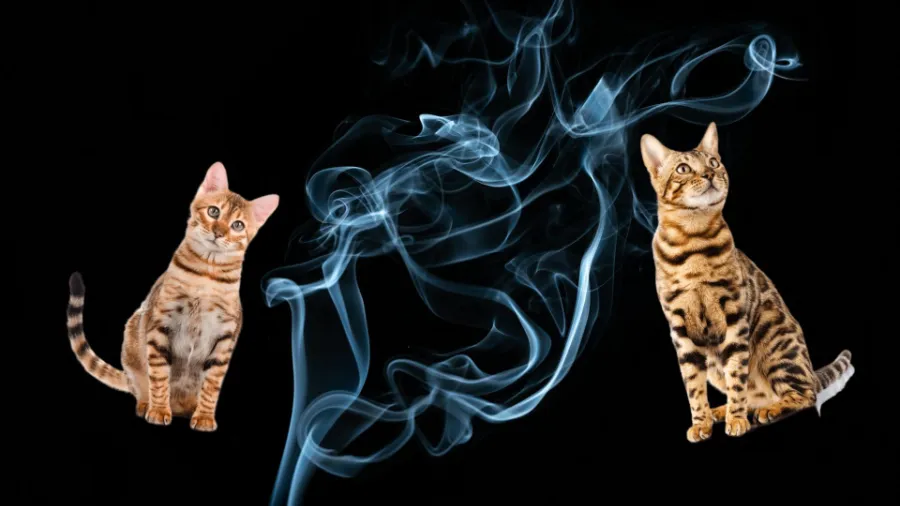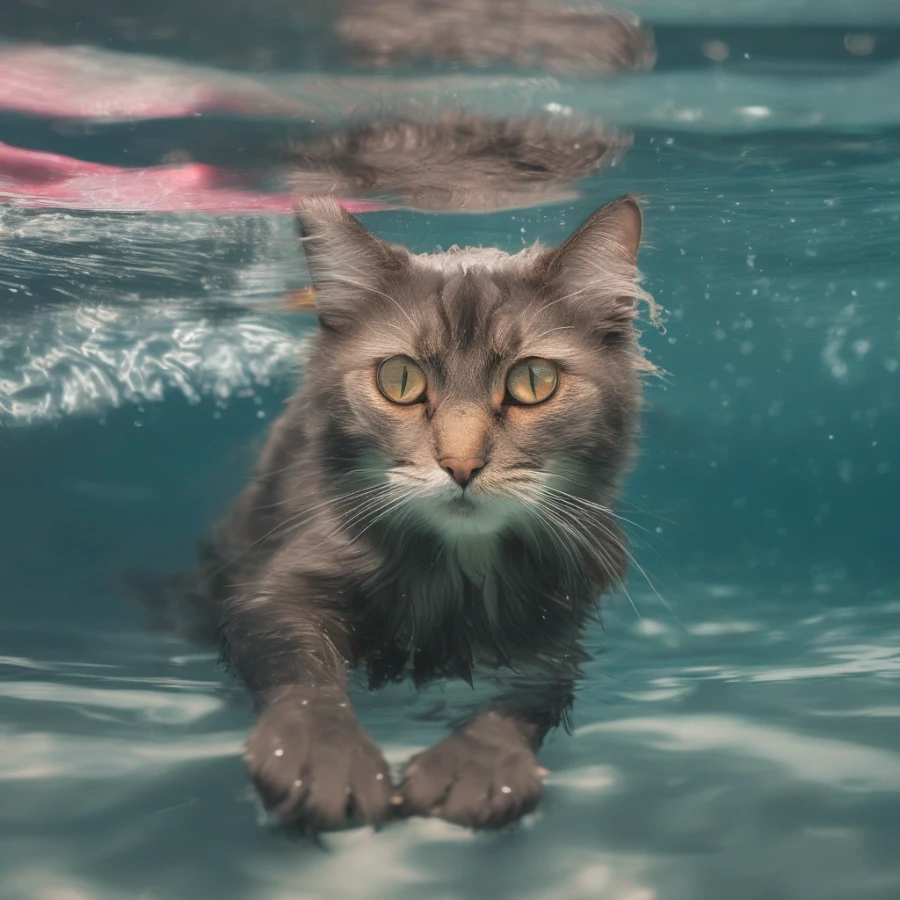Is Vaping Around Cats Bad: Nicotine Poisoning and E-Liquid Safety Around Pets

Published by: Tatsiana Korshik
Time to Read: 3 Min

The increasing popularity of vaping has led to a surge in concerns about its potential impact on pets, particularly cats. As many pet owners are aware, cats are known for their curiosity and tendency to explore their surroundings. In this context, the question arises: Is vaping around cats bad? This article delves into the risks associated with vaping, specifically focusing on nicotine poisoning and the safety of e-liquids around feline companions.
Understanding the symptoms of nicotine poisoning is crucial for cat owners. Cats may display signs of distress such as excessive drooling, diarrhea, dilated pupils, and restlessness. Recognizing these symptoms promptly is essential for seeking veterinary help and preventing further complications.
Despite the widespread use of e-cigarettes and vaping products, comprehensive studies exploring the implications of these chemicals on feline health are notably lacking. This knowledge gap poses a significant challenge for cat owners striving to ensure the well-being of their beloved pets in households where vaping is prevalent.
Inhaling or ingesting these e-liquid chemicals may present potential risks to feline health. The unique physiology of cats raises questions about how their bodies process and respond to these substances. Respiratory issues, such as coughing, wheezing, or difficulty breathing, may manifest as a result of prolonged exposure to the vapors emitted by these e-liquids.
While the immediate concerns revolve around respiratory complications, the broader and long-term consequences of these chemicals on overall feline health remain a subject of exploration. Cat owners find themselves navigating uncharted territory, attempting to strike a delicate balance between their enjoyment of vaping and the responsibility to safeguard their pet's health.
The need for dedicated research in this domain becomes increasingly apparent as the popularity of vaping continues to grow. Cat owners are urged to stay informed and exercise caution, limiting their pets' exposure to e-liquid chemicals. Increased awareness among pet owners is essential to promote responsible vaping practices and mitigate potential risks associated with these uncharted territories of feline health.
The consequences of prolonged exposure to vape smoke in cats may manifest in noticeable symptoms such as coughing, wheezing, or difficulty breathing. These signs of respiratory distress should not be taken lightly, as they could indicate underlying health issues exacerbated by the presence of inhaled substances. Understanding and recognizing these potential problems are crucial for cat owners, enabling them to take proactive measures to safeguard their pets' respiratory health.
In the realm of responsible pet ownership, being aware of the potential harm that vaping can cause to a cat's delicate respiratory health is paramount. As cats cannot communicate their discomfort verbally, it falls upon their owners to remain vigilant, seeking veterinary guidance if any respiratory issues arise. By prioritizing a cat-friendly environment and minimizing their exposure to vape smoke, owners play a pivotal role in ensuring the respiratory well-being of their feline companions.
Designating specific areas where vaping is permitted further contributes to a controlled and pet-friendly environment. This practice not only establishes clear boundaries between vaping spaces and feline living areas but also allows cat owners to manage and monitor potential exposure risks effectively. By confining vaping activities to selected zones, cat owners strike a balance between enjoying their vaping preferences and ensuring a safe space for their cats to thrive.
Adequate ventilation plays a pivotal role in maintaining a healthy vaping environment for pets. Proper air circulation helps minimize the concentration of vapor in the air, thereby reducing the risk of exposure for cats. Ensuring that designated vaping areas are well-ventilated enhances the overall living conditions for feline companions, contributing to a harmonious coexistence between cat owners and their pets.
Exploring Alternatives
Consider incorporating nicotine replacement therapies into your routine, such as patches, gums, or lozenges. These alternatives offer a means to satisfy nicotine cravings without subjecting cats to the potential risks associated with inhaling vaporized substances. Additionally, opting for closed-system vaping devices or pod mods with lower vapor production can further minimize the environmental impact on pets.
Implementing Best Practices
Designate specific areas exclusively for vaping, ensuring they are away from spaces frequented by cats. By creating a clear separation between vaping zones and feline living areas, you establish controlled environments that mitigate potential exposure risks. Enhance ventilation in these designated areas to facilitate proper air circulation, and consider using air purifiers equipped with HEPA filters to reduce airborne particles.
Regular veterinary check-ups are essential to monitor your cat's overall health, allowing veterinarians to address any emerging concerns related to potential vaping exposure promptly. Educate all household members about the importance of creating a pet-friendly vaping environment. Consistent adherence to best practices by everyone in the household contributes to a collective effort in safeguarding the well-being of feline companions.
By embracing alternatives and adhering to best practices, cat owners can strike a harmonious balance between their vaping preferences and the health of their cherished pets. These thoughtful measures contribute to fostering a safe and comfortable living environment for both vapers and their beloved feline companions.
Nicotine Poisoning in Cats
Nicotine, a common component of e-cigarettes and vaping products, is highly toxic to cats. Cats are particularly susceptible to nicotine poisoning, even in small amounts. The ingestion of nicotine can lead to various symptoms, including vomiting, increased heart rate, tremors, and, in severe cases, can result in life-threatening complications.Understanding the symptoms of nicotine poisoning is crucial for cat owners. Cats may display signs of distress such as excessive drooling, diarrhea, dilated pupils, and restlessness. Recognizing these symptoms promptly is essential for seeking veterinary help and preventing further complications.
Chemicals in E-Liquid and Their Impact
The intricate world of e-liquids extends far beyond the presence of nicotine, encompassing a diverse spectrum of chemicals such as propylene glycol, vegetable glycerin, and an array of flavorings. While these components are generally regarded as safe for human consumption, their impact on the health of our feline companions, particularly cats, remains shrouded in uncertainty.Despite the widespread use of e-cigarettes and vaping products, comprehensive studies exploring the implications of these chemicals on feline health are notably lacking. This knowledge gap poses a significant challenge for cat owners striving to ensure the well-being of their beloved pets in households where vaping is prevalent.
Inhaling or ingesting these e-liquid chemicals may present potential risks to feline health. The unique physiology of cats raises questions about how their bodies process and respond to these substances. Respiratory issues, such as coughing, wheezing, or difficulty breathing, may manifest as a result of prolonged exposure to the vapors emitted by these e-liquids.
While the immediate concerns revolve around respiratory complications, the broader and long-term consequences of these chemicals on overall feline health remain a subject of exploration. Cat owners find themselves navigating uncharted territory, attempting to strike a delicate balance between their enjoyment of vaping and the responsibility to safeguard their pet's health.
The need for dedicated research in this domain becomes increasingly apparent as the popularity of vaping continues to grow. Cat owners are urged to stay informed and exercise caution, limiting their pets' exposure to e-liquid chemicals. Increased awareness among pet owners is essential to promote responsible vaping practices and mitigate potential risks associated with these uncharted territories of feline health.
Respiratory Issues and Cats
Cats, with their uniquely delicate respiratory systems, face potential risks when exposed to vape smoke. The inhalation of vaporized substances from e-cigarettes and vaping products can lead to irritation of their sensitive lungs. Cat owners need to be particularly cautious, as persistent exposure to vape smoke may contribute to various respiratory problems, ultimately affecting the overall well-being of their feline companions.The consequences of prolonged exposure to vape smoke in cats may manifest in noticeable symptoms such as coughing, wheezing, or difficulty breathing. These signs of respiratory distress should not be taken lightly, as they could indicate underlying health issues exacerbated by the presence of inhaled substances. Understanding and recognizing these potential problems are crucial for cat owners, enabling them to take proactive measures to safeguard their pets' respiratory health.
In the realm of responsible pet ownership, being aware of the potential harm that vaping can cause to a cat's delicate respiratory health is paramount. As cats cannot communicate their discomfort verbally, it falls upon their owners to remain vigilant, seeking veterinary guidance if any respiratory issues arise. By prioritizing a cat-friendly environment and minimizing their exposure to vape smoke, owners play a pivotal role in ensuring the respiratory well-being of their feline companions.
Creating a Pet-Friendly Vaping Environment
Creating a pet-friendly vaping environment is a proactive approach to prioritize the well-being of our feline companions. Avoiding vaping around cats is a fundamental step in minimizing potential risks associated with the inhalation of vaporized substances. Cats, with their heightened sensitivity, may be adversely affected by the components present in vape smoke. By refraining from vaping in close proximity to cats, owners take a crucial step towards safeguarding their respiratory health.Designating specific areas where vaping is permitted further contributes to a controlled and pet-friendly environment. This practice not only establishes clear boundaries between vaping spaces and feline living areas but also allows cat owners to manage and monitor potential exposure risks effectively. By confining vaping activities to selected zones, cat owners strike a balance between enjoying their vaping preferences and ensuring a safe space for their cats to thrive.
Adequate ventilation plays a pivotal role in maintaining a healthy vaping environment for pets. Proper air circulation helps minimize the concentration of vapor in the air, thereby reducing the risk of exposure for cats. Ensuring that designated vaping areas are well-ventilated enhances the overall living conditions for feline companions, contributing to a harmonious coexistence between cat owners and their pets.
Alternatives and Best Practices
For cat owners who also indulge in vaping, it's crucial to explore alternatives to traditional methods and adopt best practices to ensure the well-being of their feline friends.Exploring Alternatives
Consider incorporating nicotine replacement therapies into your routine, such as patches, gums, or lozenges. These alternatives offer a means to satisfy nicotine cravings without subjecting cats to the potential risks associated with inhaling vaporized substances. Additionally, opting for closed-system vaping devices or pod mods with lower vapor production can further minimize the environmental impact on pets.
Implementing Best Practices
Designate specific areas exclusively for vaping, ensuring they are away from spaces frequented by cats. By creating a clear separation between vaping zones and feline living areas, you establish controlled environments that mitigate potential exposure risks. Enhance ventilation in these designated areas to facilitate proper air circulation, and consider using air purifiers equipped with HEPA filters to reduce airborne particles.
Regular veterinary check-ups are essential to monitor your cat's overall health, allowing veterinarians to address any emerging concerns related to potential vaping exposure promptly. Educate all household members about the importance of creating a pet-friendly vaping environment. Consistent adherence to best practices by everyone in the household contributes to a collective effort in safeguarding the well-being of feline companions.
By embracing alternatives and adhering to best practices, cat owners can strike a harmonious balance between their vaping preferences and the health of their cherished pets. These thoughtful measures contribute to fostering a safe and comfortable living environment for both vapers and their beloved feline companions.



